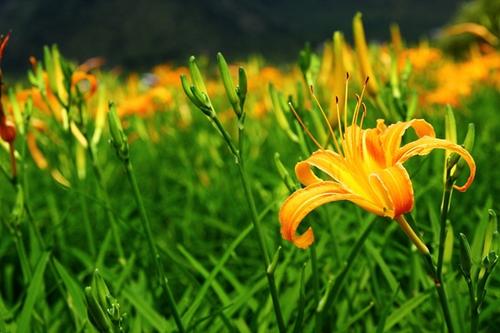Hemerocallis citrina (citron daylily) profile
Written by admin
Sep 11 2021

Hemerocallis citrina, also known as citron daylily, is a Liliaceae, perennial herb, with a "view for flowers, food for vegetables, use for medicine" reputation. Hemerocallis citrina carotene content is no less than carrots, meat fat, flower fragrance, high nutritional value, is a famous alkaline food. Fried meat with Hemerocallis citrina is one of Northeast China's home-cooked dishes, also can be played brine, shabu.
Hemerocallis citrina picture

Hemerocallis citrina info
| Botanical Name | Hemerocallis citrina |
| Common Names | Bcitron daylily |
| Plant Type | Asphodelaceae |
| Size | 3.00 to 4.00 feet wide, 1.50 to 2.00 feet high |
| Bloom time | summer |
| Sun | Full sun to part shade |
| Flower color | Lemon yellow |
| Native Range | China, eastern Asia |
Morphological characteristics of Hemerocallis citrina
Hemerocallis citrina is generally tall; Roots are subfleshy, often fusiform in middle and lower parts. Leaves are 7-20, 50-130 cm long, 6-25 mm wide. Scape of varying length, generally slightly longer than leaves, base triangulate, upper more cylindrical, branched; Bracts of hemerocallis citrina are lanceolate, to 3 -- 10 cm long below, tapering from bottom to upward, 3 -- 6 mm wide; Pedicels are shorter, usually less than 1 cm long; Hemerocallis citrina has many flowers, up to more than 100 flowers; Perianth is yellowish, sometimes with a blackish purple tip in bud; The perianth tube is 3-5 cm long, the perianth lobes (6-)7-12 cm long, the inner three lobes 2-3 cm wide. Capsule obtuse trigonal elliptic, 3-5 cm long. Seeds of more than 20, black, angulate, from flowering to seed maturity of about 40-60 days.
Ecological habits of Hemerocallis citrina
Hemerocallis citrina is a positive plants. Hemerocallis citrina is pleasant to be born on a dry hillside, wasteland, dry grass, field-side roadside.

The distribution area of Hemerocallis citrina
Hemerocallis citrina mainly distributed in Hunan Shaodong County (the township of the yellow flower), Hunan Qidong County, Henan, Shaanxi, Shanxi, Zhejiang and other places and the eastern part of the northeast.
Hemerocallis citrina main use
Medicinal
Modern Chinese and foreign scholars have further discovered the medicinal value of Hemerocallis citrina, such as Japanese scholars called daylilies "healthy brain vegetables": China's "nutrition journal" has been evaluated daylilies, has significantly reduced the role of animal serum cholesterol. People know that the increase of cholesterol is one of the important factors leading to senile diseases and body decline, can fight to age and taste delicious, nutritious vegetables are not much, and day lollies are just the opposite with these characteristics on the contrary.
Eating
The tender leaves of the golden needle are also eaten, known as "jasper bamboo shoots", but there are not many on the market, which is a rare treasure. Regular consumption of Hemerocallis Citrina can clear lung heat, soften liver qi, and prevent children from nosebleeds caused by dry heat. And Hemerocallis citrina can replenish blood, hematopoiesis, strengthen visceral function, healthy people really should eat more.

Latest Updated
- Benefits of Bugleweed - 7 Science-backed Health Benefits
- Bugleweed Dangers & Side Effects - Is It Poisonous?
- How to Plant Evergreen Trees - What You Should Know
- When to Plant Evergreens - Grow Guide for Evergreen Trees
- 12 Wonderful Evergreen Shrubs for Your Garden
- 12 Popular Evergreen Plants with Pictures for Beginners
- When And How To Prune A Lilac Bush Like a Pro
- How to Grow & Care for Lilac Vine (Hardenbergia Violacea)
- Japanese Lilac Tree (Syringa Reticulata) Care & Propagation Guide
- Shumard Oak Pros and Cons - What to Know
Popular Articles
- Winter maintenance of Antirrhinum Majus
- How to Grow Terminalia Mantaly Tree
- How to Grow and Care for Crossostephium Chinense
- How to grow Antirrhinum Majus in spring
- Peristeria Elata (Dove Orchid) Profile: Info & Care Guide
- Underwatered Snake Plant (Sansevieria Trifasciata) - Signs And How To Fix
- How to Care for Brazilian Jasmine Plant (Mandevilla Sanderi)
- How to Grow & Care for Graptopetalum Purple Delight in Summer
- Rosa Chinensis (China Rose): Plant Growing & Care Tips
- How to Care for Baby Sun Rose (Aptenia Cordifolia)